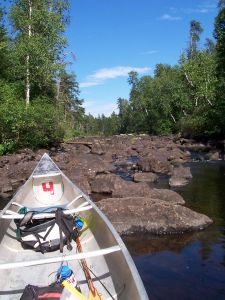Choosing a Sleeping Bag

One canoeist reaches the “end of the line” – at least for now!Photo by: Matthew Barnett (Stock Exchange)
Hello, everybody, and welcome back to the AllCampgrounds blog. I’ll be taking on the pleasant task of posting here in our continuing quest to highlight the best in camping. Expect my posts to feature news and reviews on the best camp grounds from around the U.S. and Canada. I’ll also discuss the latest tips and gear for campers, both experienced and new. Whether your goal is to go on an intense survival adventure, meet new folks at the RV camp park, or bring the family out into the country to toast s’mores and tell stories, I’ll be providing the info you need to make the most of your trek.
As a life-long resident of Florida, I grew up spending a good portion of my summers around the 600-plus acre Markham Park in Sunrise, just a short way from the beautiful Florida Everglades. Since those happy days, I’ve been on wilderness adventures up north a piece in Massachusetts and across the pond in England and Ireland, with Canada next on my list. I jumped at the chance to “get back to nature” with AllCampgrounds, and I hope I can help you do the same.
Featured Camp Grounds of the Day
From everything I’ve heard lately, Minnesota is shaping up to be one of the hot states for camping this season. This northern state has the distinction of being the “Land of 10,000 Lakes”, and a good portion of the 500 or so privately-owned Minnesota campgrounds are situated near a lake or river. There are also 66 state park camp grounds to choose from, including two national forests: Superior and Chippewa.
Canoeists will especially love the Boundary Waters Canoe Area Wilderness, in Superior Forest in northwestern Minnesota. There are over 1,5000 miles of canoe routes and countless trails (called “portages”) leading between the lakes, rivers, and streams. Fishing is also abundant here, with lake trout a popular catch in the spring. Both the canoeing and peak fishing season run from about May through September.
Recently, all Minnesota state parks enacted a handy rule that you can reserve camping and lodging spots up to a year in advance. This is really helpful for planning your trip, since we all know how hard it can be to drop everything and head out to the wild!
Camping Tips of the Day
Looking to go camping quick? Two things go into every successful camping trip: preparation and gear. The more prepared and knowledgeable you are, the more you can get out of your experience. And the better tailored your gear is to the conditions you’ll be camping in, the more you’ll notice about the wide world around you – instead of thinking about what you’re missing back at home! All campsites have their own flavor, and over time you’ll gather the gear and know-how to tackle anything.
So what’s the item to start with? A tent? A water purifier? A really long extension cord? None of the above. Today I want to talk about choosing a good sleeping bag, because one thing is true no matter where you are: sleeping well is the key to getting things done with your day, whether it’s hiking, fishing, or just exploring. And good luck convincing camping-averse friends and family to come with if you can’t promise a night’s sleep!
What Makes a Good Sleeping Bag?
The big decision here is down versus synthetic filling. Down is light and provides a lot of protection against the cold, just as nature intended. But synthetic fibers, though they tend to be heavier, will normally dry out much faster if you encounter rain, snow, sleet, that kind of thing. Other factors to consider are the temperature rating (don’t be afraid to choose one that seems “too high” if you’re dealing with winter conditions) and size. Bags should offer a comfortable fit and allow you to hood your head, but unnecessarily large ones will require more insulation to be effective. Your sleeping bag should be windproof and water resistant, and the inside should be lined, preferably with a non-cotton fabric that breathes.
For those with kids, keep these things in mind: 1) leaving just a little “room to grow” will cut down on the total number of bags they need over the years and 2) depending on how you set up your trip, they (or you!) might need to carry these things around from site to site, so beware. In just about every case, the trick is to pack light, but smart.

